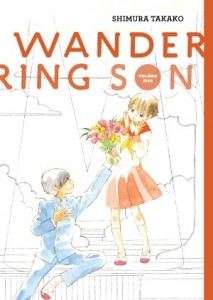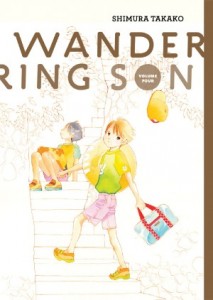By Shimura Takako. Released in Japan by Enterbrain, serialization ongoing in the magazine Comic Beam. Released in North America by Fantagraphics.
Switching to a new environment can be crippling to a young person, particularly if they’re going through a lot of other things as well. So it is with the cast of Wandering Son and middle school. Nitori tries to continue to define himself while also discovering something he’s genuinely good at, Takatsuki discovers she’s no longer the only one in the room doing what she does, and Chiba finds that even if she’s gone from overly emotional to overly stoic, she still has difficulty dealing with anyone. So, in other words, it’s an excellent depiction of anyone’s life in middle school.
We also meet some new cast members, who basically fly into Takatsuki’s circle of friends and explode like a bomb. Sarashina also sometimes wears male clothing, but it’s nothing to do with gender identity and more to do with her being an eccentric loudmouth who does whatever the hell she wants. Naturally, Takatsuki is drawn to her, as not caring about what people think is something everyone else in this book has trouble getting past. She also has a best friend, though, Shirai, who clearly is very close to her, and is very unhappy with this new girl making advances on her… um, friend. There are no yuri overtones here, really, but Shirai certainly exhibits all the classic signs of jealousy. She’s written a little flatly, so I hope we find out more about her later.
As for Chiba, you really want to reach out and give her a hug, but there’s no way she’d let you. She can’t get over her own feelings of hatred/jealousy towards Takatsuki, and attempting to suppress all emotion is not working out very well when everyone around you is giving you an excuse to go off like a rocket. So the answer, clearly, is to be antagonistic to *everyone* – even the girls in a higher grade than her, a definite no-no in Japanese society. I really hope Chiba can eventually move on past her repressed and upsetting anger, because right now she’s on a very dark road, and given she’s only 12 or so that’s depressing in itself.
Meanwhile, our hero and heroine are both facing the realities of puberty. Nitori and Ariga record their voices on tape, so they’ll be able to remember what they were like before they change. Nitori is a little upset at the idea that he won’t be able to dress as a girl anymore. Takatsuki is having an even worse time… her sports coach is demanding she wear a bra to practice, another reminder that her gender is trying to impose limits on her. The two of them finally make up, sort of, in a touching yet somewhat sad scene as they both worry about the future. Nitori, however, seems to get an idea for it, and begins to start writing a story based on his own experiences. I like the idea of Nitori’s insecurities and dreams fueling his creativity, and wonder if Takatsuki will be able to help in the process besides just having her life give him ideas.
All in all, this was an excellent transitional book in the series. As we settle into middle school, things are bound to get even more awkward, and I hope our cast finds the strength to make it through.



